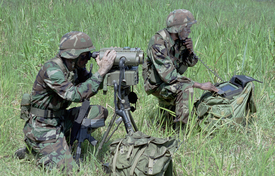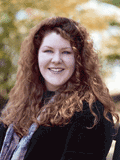


|

|
|
|
Home |
The Mil & Aero Blog
 Posted by John Keller Here's an interesting dilemma: how can people see the spot of light produced by a laser target designator in broad daylight? The answer is they often can't, and that isn't good. The problem has little, if anything, to do with potential weapons malfunctions. Laser-guided munitions are extremely good at following a laser beam to the target, and have been for nearly decades. The problem is making sure the laser is illuminating the right target. The U.S. Air Force uses forward-observers on the ground to confirm to combat pilots by radio whether the aircraft are illuminating the correct targets. It can happen that laser designators light up the wrong targets in the confusion of battle and complicated city skylines. Now consider this: broad daylight can overwhelm even visible laser spots, not to mention eye-safe lasers not visible to the naked eye. When that happens, ground observers can't help the pilots, and that could lead to politically devastating collateral damage, especially if allied munitions hit schools, hospitals, or wedding receptions. This is a dilemma that the military and the electro-optics industry are coming to grips with right now. Those involved in the electro-optics industry reported at the Photonics West trade show this week that military officials have been contacting them lately with this problem. Although it doesn't look like formal programs are in progress yet, plenty of smart folks are thinking about ways to deal with it. For some, the solution may simply be an easy modification to night-vision devices that ground observers use. By adding some filtering, these goggles and binoculars might be able to eliminate all light except the wavelength of the laser in use. No sunlight, no reflections, just a nice clean laser spot. That might not solve the entire problem, however. Some ambient light has to make it through the filter so ground observers can see the target as well as the laser designator spot. Other people are looking at aircraft-based forward-looking infrared sensors to extend focal plane array sensitivity to a broadening light spectrum to let in just the right amounts of light, and ignore the kinds of light that cause confusion. Any way they slice it, this is a big problem. It looks like solutions, however, might be on the way. 0 Comments:
<< Home |
Welcome to the lighter side of Military & Aerospace Electronics. This is where our staff recount tales of the strange, the weird, and the otherwise offbeat. We could put news here, but we have the rest of our Website for that. Enjoy our scribblings, and feel free to add your own opinions. You might also get to know us in the process. Proceed at your own risk. 
John Keller is editor-in-chief of Military & Aerospace Electronics magazine, which provides extensive coverage and analysis of enabling electronic and optoelectronic technologies in military, space, and commercial aviation applications. A member of the Military & Aerospace Electronics staff since the magazine's founding in 1989, Mr. Keller took over as chief editor in 1995.  Courtney E. Howard is senior editor of Military & Aerospace Electronics magazine. She is responsible for writing news stories and feature articles for the print publication, as well as composing daily news for the magazine's Website and assembling the weekly electronic newsletter. Her features have appeared in such high-tech trade publications as Military & Aerospace Electronics, Computer Graphics World, Electronic Publishing, Small Times, and The Audio Amateur.
Courtney E. Howard is senior editor of Military & Aerospace Electronics magazine. She is responsible for writing news stories and feature articles for the print publication, as well as composing daily news for the magazine's Website and assembling the weekly electronic newsletter. Her features have appeared in such high-tech trade publications as Military & Aerospace Electronics, Computer Graphics World, Electronic Publishing, Small Times, and The Audio Amateur.
 John McHale is executive editor of Military & Aerospace Electronics magazine, where he has been covering the defense Industry for more than dozen years. During that time he also led PennWell's launches of magazines and shows on homeland security and a defense publication and website in Europe. Mr. McHale has served as chairman of the Military & Aerospace Electronics Forum and its Advisory Council since 2004. He lives in Boston with his golf clubs.
John McHale is executive editor of Military & Aerospace Electronics magazine, where he has been covering the defense Industry for more than dozen years. During that time he also led PennWell's launches of magazines and shows on homeland security and a defense publication and website in Europe. Mr. McHale has served as chairman of the Military & Aerospace Electronics Forum and its Advisory Council since 2004. He lives in Boston with his golf clubs.
Previous Posts
Archives
|
|||||
Internet gems
THE MAE WEBSITE AUTHORS ARE SOLELY RESPONSIBLE FOR THE CONTENT AND ACCURACY OF THEIR BLOGS, INCLUDING ANY OPINIONS THEY EXPRESS, AND PENNWELL IS NOT RESPONSIBLE FOR AND HEREBY DISCLAIMS ANY AND ALL LIABILITY FOR THE CONTENT, ITS ACCURACY, AND OPINIONS THAT MAY BE CONTAINED HEREIN. THE CONTENT ON THE MAE WEBSITE MAY BE DATED AND PENNWELL IS UNDER NO OBLIGATION TO PROVIDE UPDATES TO THE INFORMATION INCLUDED HEREIN.
|
||||||
|
|
Home | About Us | Contact Us | Corporate Website | Privacy Policy | Courage and Valor Foundation | Site Map
Also Visit: Laser Focus World | Vision Systems Design | Industrial Laser Solutions Copyright © 2007: PennWell Corporation, Tulsa, OK; All Rights Reserved. | Terms & Conditions | Webmaster |